Horizontal Coil Wrapping Machine vs. Vertical Coil Wrapping Machine: Choosing the Right Packaging Solution
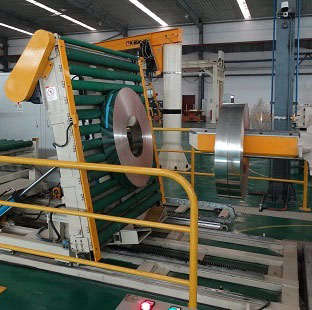
When it comes to packaging coiled materials like steel, wire, or cable, selecting the appropriate coil wrapping machine—horizontal or vertical—is not merely a preference. It's a critical strategic decision impacting operational efficiency, packaging costs, and the integrity of your products during handling and transit. Both machine types offer distinct advantages tailored to specific production environments, coil characteristics, and throughput requirements. For businesses involved in high-volume coil handling, understanding these differences is fundamental to optimizing the packaging process, enhancing productivity, ensuring consistent wrap quality, and supporting long-term operational success.
Both horizontal and vertical coil wrapping machines are vital assets in industries handling heavy-duty coiled materials, yet they operate differently and provide unique benefits. Horizontal orbital wrappers, for instance, are often the preferred choice for larger, heavier coils and high-speed production lines due to their stability and rapid wrapping cycles. Conversely, vertical wrapping machines excel in facilities with limited floor space or those primarily handling smaller, lighter coils requiring precise wrapping. Determining which machine best aligns with your specific operational needs requires a detailed comparison of their functionalities, benefits, and ideal use cases.
This guide explores the operational mechanics, key advantages, and typical applications for both horizontal and vertical coil wrapping machines, providing insights to help you make an informed decision based on your unique operational goals and constraints.
Choosing between a horizontal and vertical coil wrapping machine depends significantly on coil dimensions (size and weight), available facility space and layout, and specific production throughput requirements. Each machine type offers unique advantages that can substantially improve packaging efficiency, consistency, and overall productivity.
- 1. How Does a Horizontal Coil Wrapping Machine Work?
- 2. What Are the Key Advantages of Vertical Coil Wrapping Machines?
- 3. How Do Space and Facility Layout Affect the Choice?
- 4. What Impact Does Coil Size and Weight Have on Machine Selection?
- Conclusion: Making the Right Choice for Optimal Efficiency and Quality
1. How Does a Horizontal Coil Wrapping Machine Work?
1.1. The Mechanics of Horizontal Orbital Wrapping
A horizontal coil wrapping machine, often called an orbital wrapper, operates by passing a wrapping material shuttle through the center (eye) of a coil that is positioned horizontally, typically resting on support rollers or a conveyor. The coil itself may remain stationary or rotate slowly while the wrapping arm (shuttle carrying the film or paper roll) orbits around its circumference, applying the protective material layer by layer. This orbital motion ensures complete and uniform coverage around the entire coil surface. Modern horizontal machines feature automated controls for adjusting wrapping tension, overlap percentage, rotation speed, and the number of layers, allowing customization for different coil types and protection levels. These adjustable settings enhance their versatility for various coil dimensions and weights.
This horizontal wrapping method is particularly effective for large, heavy, and wide coils, as the horizontal orientation provides inherent stability during the wrapping cycle. The mechanics support rapid and efficient wrapping, minimizing manual intervention and ensuring consistency, which is crucial in demanding production environments.
1.2. Enhanced Speed and Throughput for High-Volume Operations
Horizontal coil wrapping machines are engineered for speed and efficiency. By automating the orbital wrapping process and facilitating easy loading/unloading (often integrated into conveyor lines), these machines can package coils significantly faster than manual methods or sometimes even vertical wrappers, depending on the setup. In high-demand industries like steel processing, aluminum production, or cable manufacturing, where maintaining production velocity is key to profitability, a horizontal machine helps sustain a smooth and rapid packaging workflow. Each coil receives consistent, high-quality wrapping, enabling operations to meet tight production schedules.
The high throughput capacity of horizontal wrapping machines makes them ideal for sectors with demanding output requirements. For example, steel service centers handling numerous heavy, large-diameter coils daily benefit immensely from the quick cycle times these machines offer. The outcome is a notable increase in throughput, reduced bottlenecks in the packaging stage, minimized downtime, and ultimately, improved overall plant productivity.
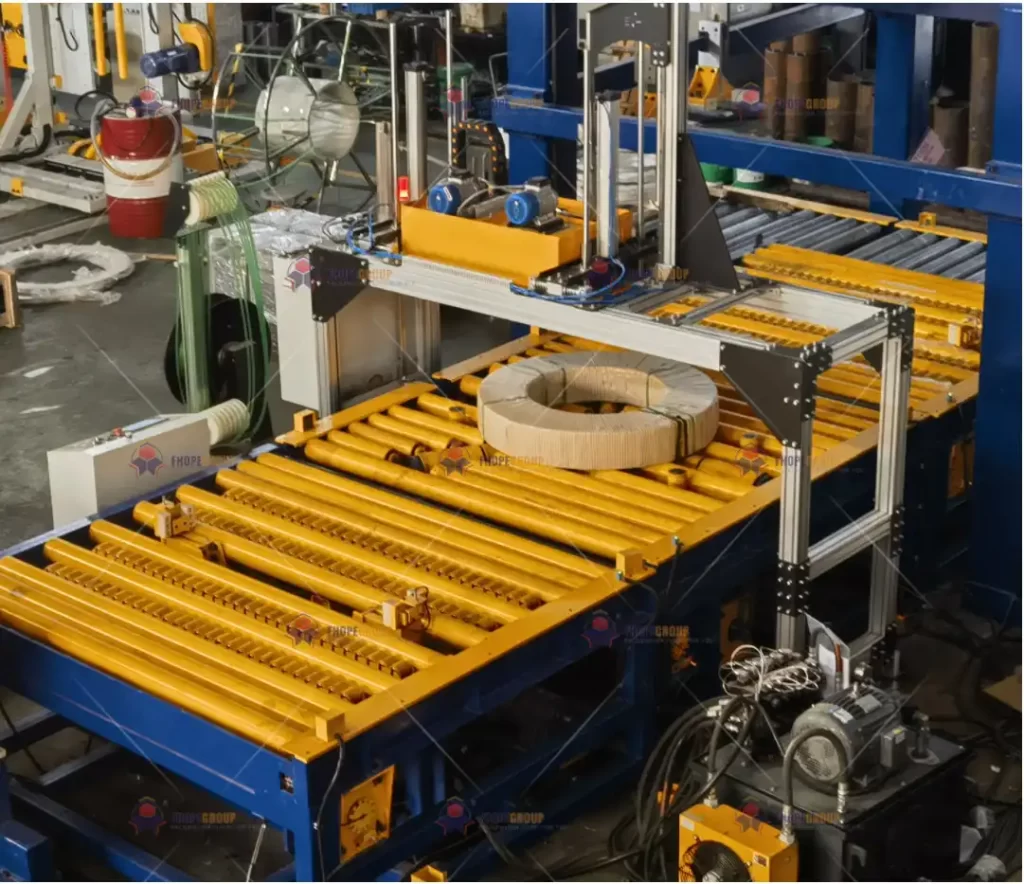
1.3. Applications and Best Use Cases for Horizontal Wrappers
Horizontal wrapping machines are best suited for facilities with sufficient floor space to accommodate the machine and associated coil handling systems (e.g., conveyors, tilters). They excel in handling large, bulky, and heavy coils that demand secure, uniform wrapping for protection during storage and transportation. Industries producing steel coils, aluminum coils, wire rod coils, large cable spools, and even tires find horizontal orbital wrappers indispensable. The stability offered by the horizontal orientation is critical for heavy-duty applications, minimizing the risk of coil shifting or damage during the wrapping process.
Operations prioritizing speed, consistency, high-volume throughput, and robust protection for large products often select horizontal machines to streamline their end-of-line packaging. For any business focused on continuous, high-output production of sizable coiled goods, a horizontal wrapping machine represents a strategic investment in both operational efficiency and product quality assurance.
2. What Are the Key Advantages of Vertical Coil Wrapping Machines?
2.1. Efficient Space Utilization in Compact Environments
Vertical coil wrapping machines are specifically designed with space efficiency as a key consideration, making them an excellent choice for facilities where floor space is limited or constrained. Unlike horizontal machines that often require a larger operational footprint for the machine and coil maneuvering, vertical wrappers handle coils in an upright (eye-to-the-sky) orientation. This vertical setup significantly reduces the required floor area, offering an efficient packaging solution without compromising wrap quality, even in tight spaces.
The vertical design allows coils, often loaded via cranes or forklifts, to be placed directly onto a turntable or wrapping platform. The wrapping mechanism then applies the film or paper as the coil rotates. This configuration facilitates easier operator access to controls and enables a more compact, streamlined wrapping station. For facilities needing to maximize floor space utilization, a vertical coil wrapper is a practical choice that integrates well into space-conscious layouts while delivering reliable performance.
2.2. Precision Wrapping for Smaller or Delicate Coils
Vertical coil wrapping machines often provide advantages when handling smaller, lighter, or more delicate coils. These machines can offer precise control over wrap tension, film placement, and layering, ensuring that even narrow-width or sensitive coils receive consistent, secure coverage without damage. This level of control helps prevent issues like over-stretching film on light coils or insufficient coverage on narrow products, which can sometimes be challenging with less specialized equipment. By offering precision, vertical machines help ensure optimal product protection while potentially minimizing material waste.
For industries dealing with materials like fine wire, electrical cables, hoses, plastic tubing, or smaller copper coils, the accuracy afforded by a vertical machine is a significant benefit. Machine parameters can typically be adjusted easily to accommodate different coil dimensions and wrapping requirements, allowing for smooth transitions between varying product types and reducing the need for time-consuming manual adjustments.
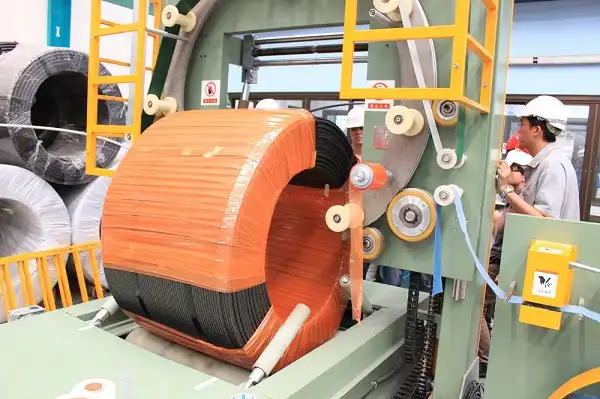
2.3. Adaptability and Versatility Across Varied Coil Types
Vertical coil wrapping machines are generally designed for adaptability, featuring settings that can be customized based on coil diameter, width, weight, material type, and specific packaging needs (e.g., full wrap, edge protection). This versatility makes them well-suited for facilities that process a diverse range of coil types, from small spools of electrical wire to medium-sized coils of hose or tubing. The relative ease of adjusting settings allows operators to efficiently switch between different product runs, maintaining productivity even in high-mix packaging environments.
The adaptability of vertical machines proves particularly valuable in industries with varied packaging demands, such as distribution centers, electrical component manufacturing, or automotive suppliers. By accommodating different products quickly, the machine minimizes changeover time and supports a flexible production flow. Vertical machines offer a seamless packaging solution for businesses needing to wrap multiple coil sizes and types without requiring extensive machine reconfiguration for each product.
3. How Do Space and Facility Layout Affect the Choice?
3.1. Optimizing Spacious Layouts with Horizontal Machines
When evaluating coil wrapping options, the available facility layout is a critical factor. Horizontal coil wrapping machines generally require more floor space, not just for the machine itself but also for associated infeed/outfeed conveyors and the horizontal orientation of the coils during processing. Facilities with ample, open layouts can comfortably accommodate these systems, allowing for efficient material flow and operator access. The horizontal configuration, while space-intensive, provides excellent stability for heavy coils and often integrates smoothly into automated production lines.
In a well-designed layout, a horizontal wrapper can be a central component of a streamlined packaging process, enabling coils to move seamlessly from production or slitting lines through wrapping and onto storage or shipping areas. By dedicating sufficient space, businesses can leverage the high-speed capabilities of horizontal machines to maximize throughput. For facilities prioritizing high volume and possessing the necessary space, a horizontal machine can be optimally integrated to ensure consistent, efficient output.
3.2. Maximizing Limited Space with Vertical Machines
For facilities grappling with space constraints, vertical coil wrapping machines present a significantly more compact alternative. By handling coils in an upright position, these machines minimize the required floor area, making them easier to fit into crowded production floors or smaller workshops. This inherent space efficiency is a major advantage for businesses needing to add wrapping capabilities without undertaking major layout reorganizations or expansions.
Vertical machines offer flexibility in placement; they can often be positioned in corners, along walls, or integrated into cellular manufacturing setups, thereby optimizing the use of available space. For operations needing effective coil packaging within a limited footprint, vertical wrappers provide the necessary functionality in a space-saving design, making them a practical and efficient choice.
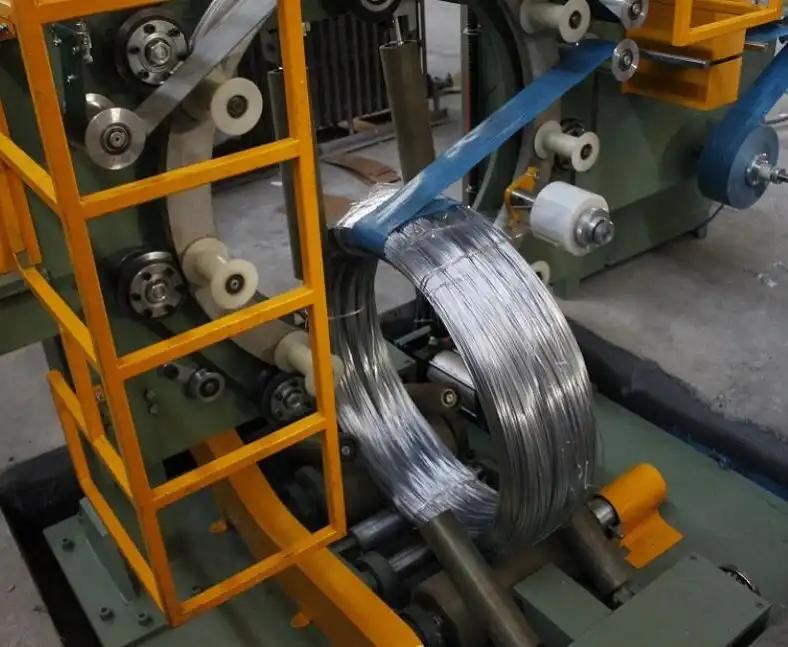
3.3. Aligning Machine Choice with Facility Workflow
Beyond just physical space, the facility's overall workflow dynamics are crucial in selecting the right wrapper. High-speed, continuous flow operations handling uniform large coils might find a horizontal machine integrates better, especially if automation and conveyor systems are prevalent. Conversely, workflows involving frequent changeovers between different coil sizes, weights, or materials might benefit more from the adaptability and potentially simpler loading/unloading (depending on handling equipment) of a vertical machine, even if space isn't the primary constraint. Assessing the interplay between layout, material handling methods, and production flow patterns helps determine which machine type best supports the facility’s unique operational rhythm.
Ultimately, the decision between horizontal and vertical coil wrapping should balance spatial limitations, production volume goals, product characteristics, and existing workflow processes. Each machine type offers clear advantages under specific conditions. The optimal choice is the one that integrates most effectively into the facility's overall operational strategy, contributing to a smoother, more efficient, and productive packaging environment.
4. What Impact Does Coil Size and Weight Have on Machine Selection?
4.1. Handling Large, Heavy Coils with Horizontal Machines
Horizontal coil wrapping machines are robustly designed specifically with large, heavy coils in mind. When processing substantial coils, such as those found in the steel, aluminum, or heavy-gauge wire industries, stability during wrapping is paramount. The horizontal orientation provides a stable base, ensuring the coil remains secure on rollers or conveyors and preventing unwanted movement (like tipping or excessive vibration) that could compromise wrap quality or safety. With the coil's significant weight distributed horizontally, the orbital wrapping arm can apply consistent tension and layering without the risk of destabilizing the load, critical for heavy-duty packaging applications.
This inherent stability is vital for industries where maintaining coil integrity and ensuring adequate protection for valuable, heavy products during subsequent handling and shipping are non-negotiable. By choosing a horizontal machine for large coil applications, businesses invest in stable, reliable, and consistent wrapping, minimizing the risk of product damage and enhancing overall package security.
4.2. Efficiently Wrapping Smaller or Lighter Coils with Vertical Machines
For operations primarily dealing with smaller, lighter, or narrower coils, a vertical coil wrapping machine often provides the necessary precision and control without the heavy-duty structural requirements (and associated footprint/cost) of larger horizontal machines. Vertical wrappers allow operators to securely wrap coils of materials like electrical wire, hydraulic hoses, plastic tubing, or smaller non-ferrous metal coils. They typically offer fine-tuned control over film tension and application, crucial for preventing damage to delicate materials or ensuring full coverage on narrow coil faces.
The vertical configuration generally simplifies handling for lighter coils (often loaded manually or with lighter lifting equipment) and allows for rapid adjustments between different coil sizes and types. This makes vertical machines highly efficient and versatile for facilities packaging a diverse range of smaller coiled products throughout a shift, supporting flexible production schedules without significant downtime for reconfiguration.
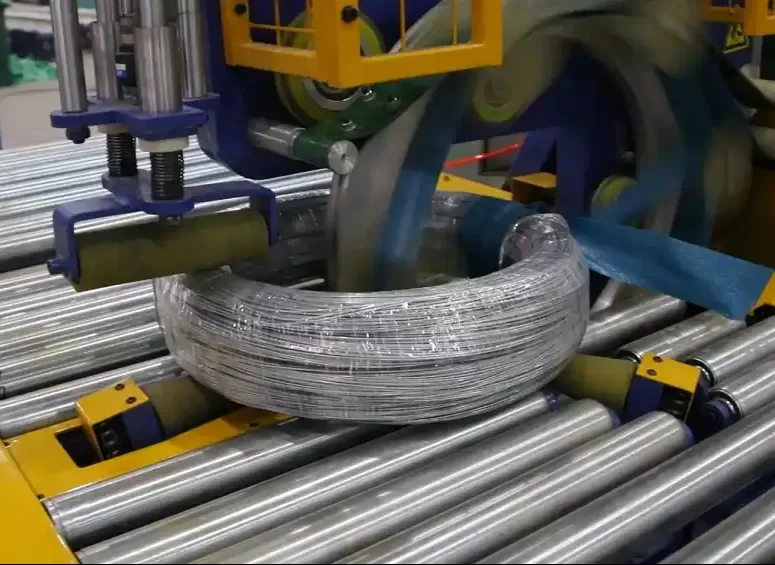
4.3. Matching Machine Type to Specific Product Requirements
Ultimately, selecting the most suitable coil wrapping machine hinges on aligning its capabilities with the specific physical requirements of the coils being packaged.
- Heavy, Large-Diameter, Wide Coils: Operations predominantly handling these typically benefit from the stability, robustness, and often higher speeds of horizontal machines.
- Lighter, Smaller-Diameter, Narrow Coils: Facilities managing these, especially with varied product mixes, often find the precision, adaptability, and smaller footprint of vertical machines to be the ideal solution.
- Mixed Coil Sizes/Weights: The decision becomes more nuanced. Factors like the proportion of large vs. small coils, available space, budget, and integration requirements will guide the choice, potentially favoring the machine type that best handles the most critical or highest volume products.
Matching the machine type directly to the product profile is a fundamental strategic decision. It ensures not only an efficient workflow and optimized material usage but also guarantees the appropriate level of protection and package quality for every coil, safeguarding product value throughout the supply chain.
Conclusion: Making the Right Choice for Optimal Efficiency and Quality
Choosing between a horizontal and a vertical coil wrapping machine requires a thorough analysis that extends beyond basic considerations of space or initial cost. It demands a deep understanding of how each machine type aligns with your specific production volumes, primary coil specifications (size, weight, material), existing facility layout, material handling capabilities, and overall workflow integration. Horizontal machines generally offer unparalleled stability and speed for large, heavy coils within high-throughput operations. Vertical machines provide space-efficient, adaptable, and precise solutions, particularly well-suited for facilities with limited floor area or those handling a diverse range of smaller to medium-sized coils.
Investing in the right coil wrapping machine translates directly into tangible benefits: enhanced operational efficiency, consistent packaging quality, reduced labor requirements, minimized material waste, and improved product protection. By carefully evaluating your operational priorities and product characteristics against the distinct advantages offered by horizontal and vertical systems, you can select the machine that best fits your needs. This strategic choice empowers your facility to streamline its packaging process, boost productivity, reduce errors, and ensure every coil—large or small, heavy or light—is securely wrapped and ready for its journey through the supply chain.
Whether opting for the robust power of a horizontal coil wrapping machine or the compact versatility of a vertical model, the decision significantly influences packaging efficiency, quality consistency, and overall operational flow. Selecting the machine best matched to your application is key to enhancing productivity and achieving reliable, high-quality packaging outcomes for every coil.
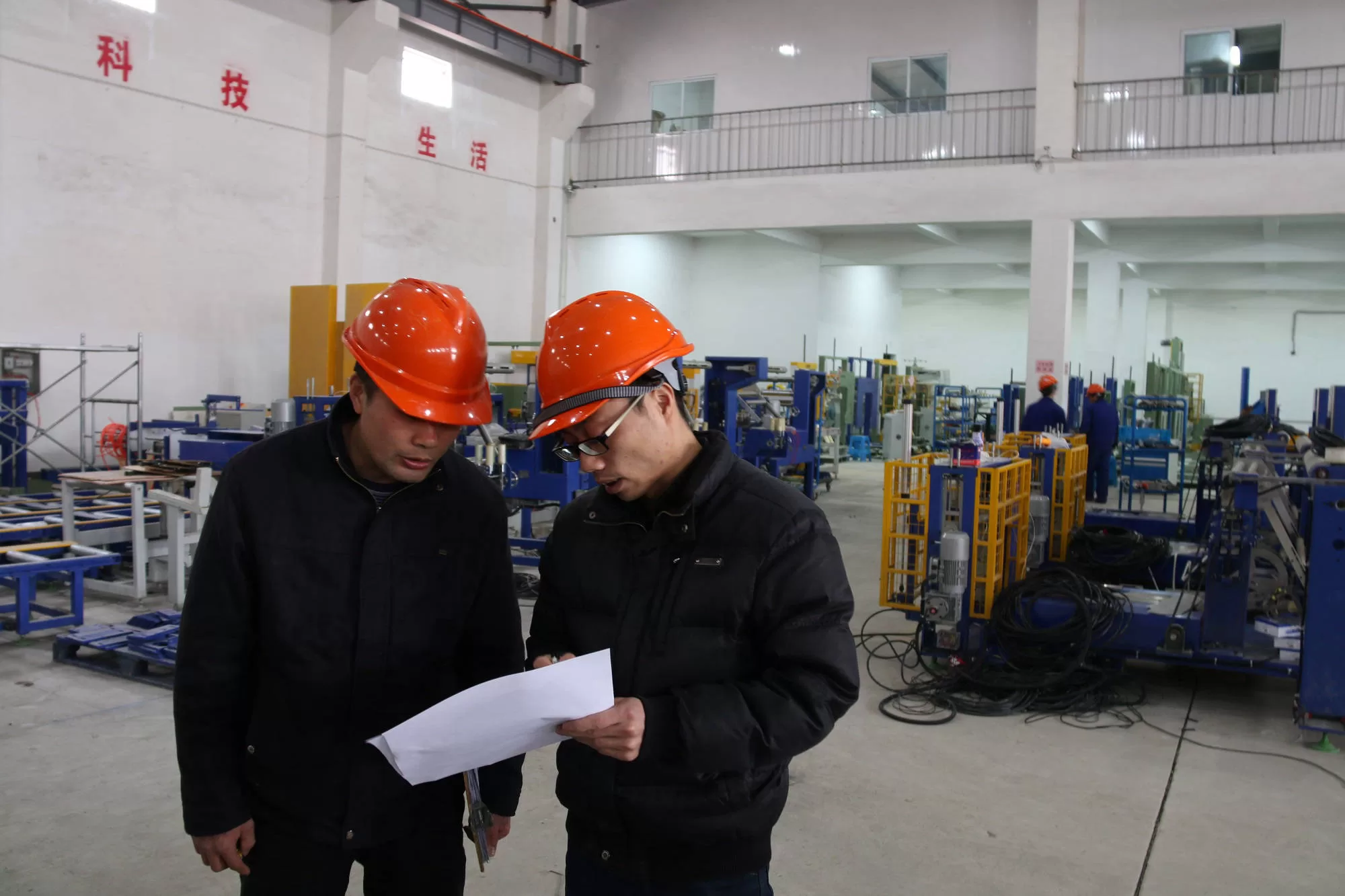
Get Your Best Solution !